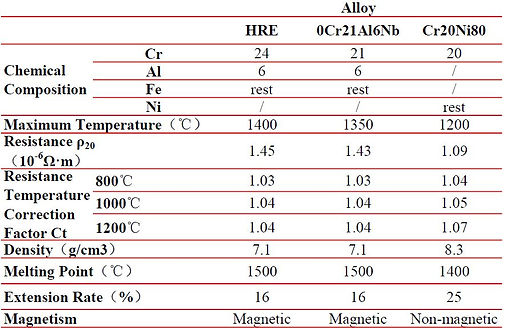Choose the Right Alloy
Iron-Chromium-Aluminum (FeCrAl)
High operating temperature
The highest temperature of HRE alloy in iron-chromium-aluminum electrothermal alloy can reach up to 1400 °C, in comparison the maximum temperature of Cr20Ni80 alloy at 1200 °C.
Long service life
Operating at the same temperature, the lifetime of the iron-chromium-aluminum component can be 2 to 4 times that of the nickel-chromium component.
High surface load
The high surface load of our iron-chromium-aluminum allows quick temperature rise and can sustain high temperature for the longest possible lifetime.
Good oxidation resistance
The Al2O3 oxide film formed on the surface of the iron-chromium-aluminum alloy has a dense structure and good adhesion to the substrate, and it is not easily contaminated by scattering. In addition, Al2O3 has a high electrical resistivity and a high melting point. these factors contributes to the excellent oxidation resistance of the Al2O3 oxide film.
The carburization resistance is also better than that of Cr2O3 formed on the surface of the nickel-chromium alloy.
Small specific gravity
Iron-chromium-alloys have a lower specific gravity than nickel-chromium alloys, which means that iron-chromium-aluminum is more economically viable than nickel-chromium when making the same components.
High resistivity
Iron-chromium-aluminum alloys have higher electrical resistivity than nickel-chromium alloys. During components designing, larger-sized alloy materials can be used, which is beneficial to extend component life. This is especially important for fine-alloy wires.
When the same material is used, the higher the resistivity, the less material is needed and therefore the less space it is occupied in the furnace. In addition, the electrical resistivity of the iron-chromium-aluminum alloy is less affected by heat treatment than that of the nickel-chromium alloy.
Good sulfur resistance
Iron-chromium-aluminum has good corrosion resistance to sulfur-containing atmospheres and surfaces contaminated with sulfur-containing substances, while nickel-chromium can be severely damaged.
Affordable price
Iron chromium aluminum is less expensive than nickel chromium since it does not contain scarce nickel.
The disadvantage of iron-chromium-alloy is mainly that the high-temperature strength is low, and its plasticity increases as the temperature increases. At 1000 ° C or higher, the material tends to slowly elongate due to its own weight, causing deformation of the component.
In addition, after being cooled in the furnace for a long time after being heated at a high temperature, it becomes brittle as the grain grows, and cannot be bent in a cold state. These shortcomings should be avoided and overcome in design and use.
Nickel-Chromium (NiCr)
High temperature strength
Nickel-chromium alloys are higher in strength than iron-chromium-aluminum, and are not easily deformed when used at high temperatures.
Stable plasticity after long-term use
Nickel-chromium alloy will not become brittle after cooling for a long time. Therefore, the heating element is relatively reliable to use and easy to repair after damage.
High emissivity
The fully oxidized nickel-chromium alloy has a higher emissivity than that of iron-chromium-aluminum alloy. As a result, when the surface load is the same, the temperature of the nichrome component is slightly lower than that of the iron-chromium-aluminum.
Non-magnetic
Nickel-chromium alloys are non-magnetic (Cr15Ni60 has weak magnetic properties at low temperatures), which is more suitable for some appliances used at low temperatures. Iron-chromium-aluminum alloys are not magnetic at temperatures above 600 °C.
Better corrosion resistance
Nickel-chromium alloys are generally more resistant to corrosion than unoxidized iron-chromium-alloys (except for sulfur-containing atmospheres and certain controlled atmospheres).
Technical Specification

Dimensions


